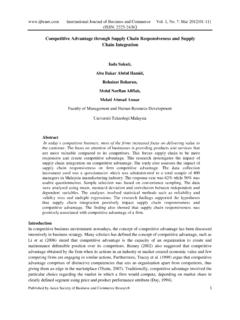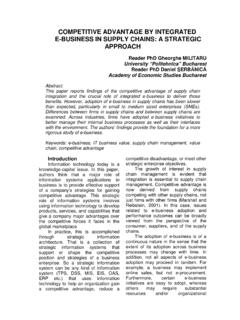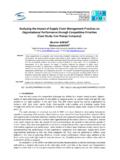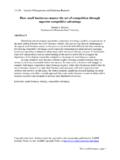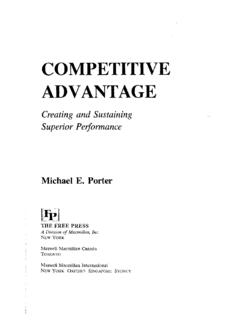Transcription of How Information Gives You Competitive …
1 How Information Gives You Competitive [28/11/2016 11:34:33]TECHNOLOGYHow Information Gives You CompetitiveAdvantageby Michael E. Porter and Victor E. MillarFROM THE JULY 1985 ISSUE $ 17 The Information revolution is sweeping through our economy. No company can escape its reductions in the cost of obtaining, processing, and transmitting Information are changingthe way we do general managers know that the revolution is under way, and few dispute its importance. As more and more oftheir time and investment capital is absorbed in Information technology and its effects, executives have a growingawareness that the technology can no longer be the exclusive territory of EDP or IS departments. As they see theirrivals use Information for Competitive advantage , these executives recognize the need to become directly involvedin the management of the new technology. In the face of rapid change, however, they don t know article aims to help general managers respond to the challenges of the Information revolution.
2 How willadvances in Information technology affect competition and the sources of Competitive advantage ? What strategiesshould a company pursue to exploit the technology? What are the implications of actions that competitors mayMENUSUBSCRIBE SIGN IN REGISTER SUBSCRIBE 3/4 REMAINING | How Information Gives You Competitive [28/11/2016 11:34:33]already have taken? Of the many opportunities for investment in Information technology, which are the mosturgent?To answer these questions, managers must first understand that Information technology is more than just , Information technology must be conceived of broadly to encompass the Information that businesses createand use as well as a wide spectrum of increasingly convergent and linked technologies that process the addition to computers, then, data recognition equipment, communications technologies, factory automation, andother hardware and services are Information revolution is affecting competition in three vital ways:It changes industry structure and, in so doing, alters the rules of creates Competitive advantage by giving companies new ways to outperform their spawns whole new businesses, often from within a company s existing discuss the reasons why Information technology has acquired strategic significance and how it is affecting allbusinesses.
3 We then describe how the new technology changes the nature of competition and how astute companieshave exploited this. Finally, we outline a procedure managers can use to assess the role of Information technology intheir business and to help define investment priorities to turn the technology to their Competitive SignificanceInformation technology is changing the way companies operate. It is affecting the entire process by whichcompanies create their products. Furthermore, it is reshaping the product itself: the entire package of physicalgoods, services, and Information companies provide to create value for their important concept that highlights the role of Information technology in competition is the value chain . Thisconcept divides a company s activities into the technologically and economically distinct activities it performs to dobusiness. We call these value activities. The value a company creates is measured by the amount that buyers arewilling to pay for a product or service.
4 A business is profitable if the value it creates exceeds the cost of performingthe value activities. To gain Competitive advantage over its rivals, a company must either perform these activities ata lower cost or perform them in a way that leads to differentiation and a premium price (more value ).12 How Information Gives You Competitive [28/11/2016 11:34:33]A company s value activities fall into nine generic categories (see Exhibit I). Primary activities are those involvedin the physical creation of the product, its marketing and delivery to buyers, and its support and servicing after activities provide the inputs and infrastructure that allow the primary activities to take place. Every activityemploys purchased inputs, human resources, and a combination of technologies. Firm infrastructure, including suchfunctions as general management, legal work, and accounting, supports the entire chain . Within each of thesegeneric categories, a company will perform a number of discrete activities, depending on the particular , for example, frequently includes activities such as installation, repair, adjustment, upgrading, and partsinventory I The value chainA company s value chain is a system of interdependent activities, which are connected by linkages.
5 Linkages existwhen the way in which one activity is performed affects the cost or effectiveness of other activities. Linkages oftencreate trade-offs in performing different activities that should be optimized. This optimization may require trade-offs. For example, a more costly product design and more expensive raw materials can reduce after-sale servicecosts. A company must resolve such trade-offs, in accordance with its strategy, to achieve Competitive also require activities to be coordinated. On-time delivery requires that operations, outbound logistics, andservice activities (installation, for example) should function smoothly together. Good coordination allows on-timedelivery without the need for costly inventory. Careful management of linkages is often a powerful source ofcompetitive advantage because of the difficulty rivals have in perceiving them and in resolving trade-offs acrossorganizational Information Gives You Competitive [28/11/2016 11:34:33]The value chain for a company in a particular industry is embedded in a larger stream of activities that we term the value system (see Exhibit II).
6 The value system includes the value chains of suppliers, who provide inputs (suchas raw materials, components, and purchased services) to the company s value chain . The company s product oftenpasses through its channels value chains on its way to the ultimate buyer. Finally, the product becomes a purchasedinput to the value chains of its buyers, who use it to perform one or more buyer II The value systemLinkages not only connect value activities inside a company but also create interdependencies between its valuechain and those of its suppliers and channels. A company can create Competitive advantage by optimizing orcoordinating these links to the outside. For example, a candy manufacturer may save processing steps by persuadingits suppliers to deliver chocolate in liquid form rather than in molded bars. Just-in-time deliveries by the supplierHow Information Gives You Competitive [28/11/2016 11:34:33]may have the same effect. But the opportunities for savings through coordinating with suppliers and channels go farbeyond logistics and order processing.
7 The company, suppliers, and channels can all benefit through betterrecognition and exploitation of such advantage in either cost or differentiation is a function of a company s value chain . A company s costposition reflects the collective cost of performing all its value activities relative to rivals. Each value activity hascost drivers that determine the potential sources of a cost advantage . Similarly, a company s ability to differentiateitself reflects the contribution of each value activity toward fulfillment of buyer needs. Many of a company sactivities not just its physical product or service contribute to differentiation. Buyer needs, in turn, depend notonly on the impact of the company s product on the buyer but also on the company s other activities (for example,logistics or after-sale services).In the search for Competitive advantage , companies often differ in Competitive scope or the breadth of theiractivities. Competitive scope has four key dimensions: segment scope, vertical scope (degree of verticalintegration), geographic scope, and industry scope (or the range of related industries in which the companycompetes).
8 Competitive scope is a powerful tool for creating Competitive advantage . Broad scope can allow the company toexploit interrelationships between the value chains serving different industry segments, geographic areas, or relatedindustries. For example, two business units may share one sales force to sell their products, or the units maycoordinate the procurement of common components. Competing nationally or globally with a coordinated strategycan yield a Competitive advantage over local or domestic rivals. By employing a broad vertical scope, a companycan exploit the potential benefits of performing more activities internally rather than use outside selecting a narrow scope, on the other hand, a company may be able to tailor the value chain to a particulartarget segment to achieve lower cost or differentiation. The Competitive advantage of a narrow scope comes fromcustomizing the value chain to best serve particular product varieties, buyers, or geographic regions. If the targetsegment has unusual needs, broad-scope competitors will not serve it the value chainInformation technology is permeating the value chain at every point, transforming the way value activities areperformed and the nature of the linkages among them.
9 It also is affecting Competitive scope and reshaping the wayproducts meet buyer needs. These basic effects explain why Information technology has acquired strategicsignificance and is different from the many other technologies businesses Information Gives You Competitive [28/11/2016 11:34:33]Every value activity has both a physical and an Information -processing component. The physical componentincludes all the physical tasks required to perform the activity. The Information -processing component encompassesthe steps required to capture, manipulate, and channel the data necessary to perform the value activity creates and uses Information of some kind. A logistics activity, for example, uses informationlike scheduling promises, transportation rates, and production plans to ensure timely and cost-effective delivery. Aservice activity uses Information about service requests to schedule calls and order parts, and generates informationon product failures that a company can use to revise product designs and manufacturing activity s physical and Information -processing components may be simple or quite complex.
10 Different activitiesrequire a different mix of the two components. For instance, metal stamping uses more physical processing thaninformation processing; processing of insurance claims requires just the opposite most of industrial history, technological progress principally affected the physical component of whatbusinesses do. During the Industrial Revolution, companies achieved Competitive advantage by substitutingmachines for human labor. Information processing at that time was mostly the result of human the pace of technological change is reversed. Information technology is advancing faster than technologies forphysical processing. The costs of Information storage, manipulation, and transmittal are falling rapidly and theboundaries of what is feasible in Information processing are at the same time expanding. During the IndustrialRevolution, the railroad cut the travel time from Boston, Massachusetts, to Concord, New Hampshire, from fivedays to four hours, a factor of 30. But the advances in Information technology are even greater.

